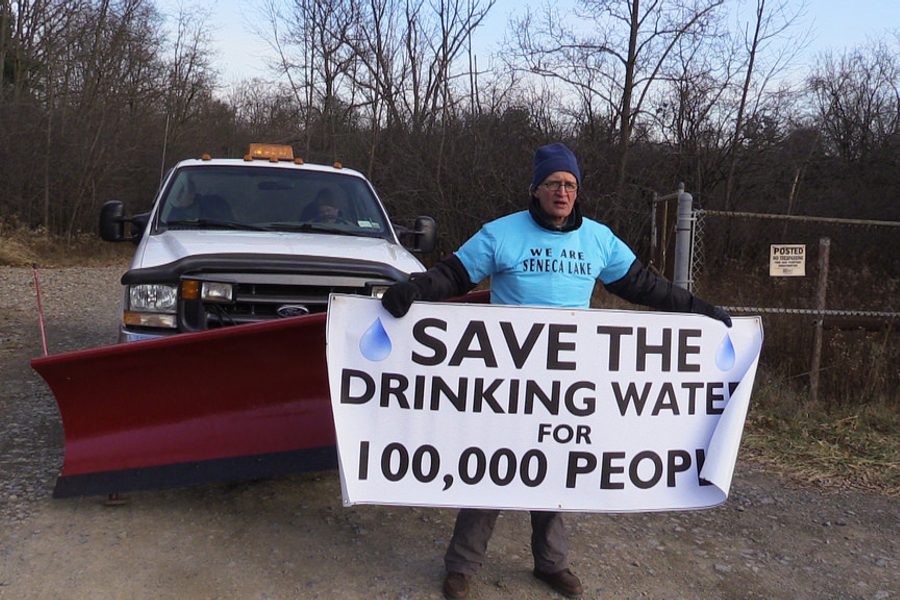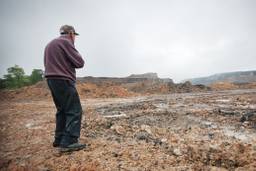Dozens of Activists Arrested in Battle Against a Fracking “Gateway Drug” in New York
Residents of New York’s Finger Lakes argue that gas projects would spell ecological and economic disaster for the region.
Molly Bennet

Tens of thousands of years ago, as massive sheets of ice moved across river valleys in what’s now west-central New York, they cut 11 deep grooves that eventually became the Finger Lakes. Some 390 million years before that, in the sea that once covered the Appalachian Basin, algae and other organic matter mixed together with mineral particles and settled, a black sludge that was transformed over millions of years into the Marcellus Shale, the gas-rich rock formation that stretches from New York down to West Virginia. And as the sea dried up, it left behind huge deposits of salt, which began to be mined in the nineteenth century, creating a honeycomb of hollowed-out caverns deep underground.
Today, this geological history is at the heart of a battle being waged by Finger Lakes residents to stop two proposed gas storage projects they believe pose a grave risk to the ecology of region and the people who live there — projects that, in the words of biologist and author Sandra Steingraber, threaten to “turn us into an extraction colony for investor profits.”
On Wednesday evening, Steingraber was taken away in handcuffs from the small town hall in Reading, New York, alongside 86-year-old Roland Micklem and Colleen Boland, a retired Air Force sergeant. All three had pled guilty to trespassing on the property of Crestwood Midstream, a Houston-based natural gas company that stores fracked methane in giant underground salt caverns along the western shore of Seneca Lake, the largest of the Finger Lakes.
Steingraber, Micklem and Boland, who each chose to spend 15 days in jail rather than pay the $250 fine, are among more than 50 people who have been arrested over the past four weeks during a series of blockades to protest Crestwood’s plans to expand its methane storage in the salt caverns by a third. (Micklem ended up being released Thursday due to health concerns.)
In addition to the methane expansion, the activists are also fighting a separate Crestwood project that would convert two caverns into a facility that could store 2.1 billion barrels of liquefied petroleum gas (LPG) — mostly propane and some butane.
The projects, which were first proposed five years ago by Inergy, Crestwood’s predecessor company, have faced strong opposition from locals who see the potential for catastrophic accidents and environmental devastation, and fear the industrialization of a region whose economic condition depends heavily on its environmental integrity. So far, 13 municipalities have passed resolutions opposing the LPG project, including Watkins Glen, which lies two miles south of the Crestwood site and is home to 1,900 people.
But influential state politicians like Senators Kirsten Gillibrand and Charles Schumer have remained silent on the issue despite pleas from the projects’ opponents to intervene, and the project has won the support of the Schuyler County Legislature (though not without controversy).
In August, New York’s Department of Environmental Conservation, which has jurisdiction over the LPG project, announced that it would hold off on ruling on the project until an “issues conference” could be held to examine the concerns about the project’s safety. But last week, the DEC issued a draft permit for the project, which protesters have interpreted as a signal that the agency is leaning toward approval. Primary jurisdiction on the methane storage expansion, meanwhile, lies with the Federal Energy Regulatory Committee (FERC), which last month gave Crestwood the go-ahead to begin construction—a development that sparked the wave of civil disobedience.
“These are just ordinary people who have exhausted every possible means of expressing their opposition and are at wits’ end,” says Yvonne Taylor, a co-founder of Gas Free Seneca, a group formed in 2011 to oppose the Crestwood projects.
One major concern cited by the protesters is the geological stability of the salt caverns where the gas would be stored, and the risk of a disaster such as an explosion or collapse in the salt caves, that could lead to human casualties and ecological devastation.
“These caverns were never designed to hold hydrocarbon gases,” says Steingraber, who lives with her family in nearby Trumansburg and is one of the organizers of We Are Seneca Lake, the group that is staging the blockades. “If you wanted to design a structure to safely store a whole bunch of compressed, explosive hydrocarbon gases underground, the architect wouldn’t come up with this plan. This is just accidental space that’s left over.”
This year, Rob MacKenzie, the former CEO of Cayuga Medical Center, performed a risk analysis of the Crestwood LPG project. According to his findings, there is a more than 40 percent chance that a disaster of “serious or extremely serious consequences” will occur over the next 25 years, whether in the caverns themselves or during the transport of the gas to the facilities via truck and rail, another fear of the opponents of the project. (A consulting firm hired by Crestwood has disputed the validity of the study.)
According to Mackenzie’s report, between 1972 and 2012 18 “serious or extremely serious” incidents occurred at salt cavern storage facilities in the United States. In Hutchinson, Kansas, for example, in 2001, gas leaked from a salt-mine storage facility and migrated seven miles underground to the city center, setting off a series of explosions that killed two people.
“As much as the company wants us to believe this is perfectly safe, you can’t rule out equipment failure or human error,” says Taylor’s partner, Joseph Campbell, also a co-founder of Gas Free Seneca.
Opponents of the Crestwood projects also note that there is evidence that one of the caverns in which the gas will be stored suffered a partial collapse several decades ago, leading to fears that Seneca Lake will be the site of a disaster like the one that occurred Bayou Corne, Louisiana, in 2012, when a salt mine collapsed, creating a sinkhole that is now more than 26 acres wide and still growing.
“Even though the risk of catastrophe may not be a … probable event,” says Steingraber, “if the consequences are unfixable devastation and the loss of drinking water for a huge number of people, we find that to be an unacceptable situation.”
Faith Meckley, one of the organizers of We Are Seneca Lake, was born and raised in Geneva, at the north shore of the lake, and grew up hiking in Watkins Glen State Park. A journalism student at Ithaca College, she took the fall semester off to take part in the Great March for Climate Action, walking 1,800 miles, from New Mexico to the Ohio-Pennsylvania border, before leaving the march in October to return to the Finger Lakes and help organize the Seneca Lake fight.
“The scariest thing is imagining that beautiful area we have on the south end of the lake… sometimes I imagine that as a crater,” says Meckley. “And that’s what it could become. If there were a collapse or some sort of major event and an explosion were to occur, it could be a huge and catastrophic event.”
Opponents of the projects are also concerned about the potential impact on water quality in Seneca Lake, which provides drinking water for 100,000 local residents. When gas is pushed into the salt caverns, Steingraber explains, it displaces salty brine, which could potentially travel through fissures in the rock and work its way into the lake — which is already the saltiest of the Finger Lakes — as could the gas itself. Due to the depth of Seneca Lake and the way it drains, says Steingraber, should a contamination occur, “the amount of time it would take to get all the contaminants out would be measured in human generations, not days or weeks.”
And then there are the economic concerns. More than 20 million tourists visit the Finger Lakes each year, attracted by the dramatic landscape’s glacial gorges, lakes and waterfalls. Many locals, beyond their own personal attachment to that landscape, worry about what will happen to the tourism if it is marred by industrialization.
Tourists also visit the Finger Lakes for its thriving wine industry, which last month led Wine Enthusiast magazine to declare New York State the “wine region of the year.” Considered the crown jewel of the Finger Lakes, Seneca Lake is largely responsible for the unique microclimate that has allowed more than 100 wineries to flourish — “the heartbeat of our local economy,” says Steingraber. But wine grapes are a product of their environment, sensitive to pollution and contaminants.
“This whole industry depends on clean water and fertile soil and clean air,” says Art Hunt. Hunt is the co-owner, with his wife, Joyce, of Hunt Country Vineyards, a sixth-generation farm on nearby Keuka Lake that is one of some 250 area businesses that have joined Gas Free Seneca. Moreover, should an industrial accident occur, even if the ecological impact was minimal, some locals fear that it would come to define the region.
“This area is known as the Finger Lakes wine region, and that’s what’s getting international attention,” says Joyce Hunt. “If there were to be an accident, … the tourism would stop.”
Crestwood has maintained that the proposed storage facilities are perfectly safe, and has touted the LPG project, which will it says will create 10 permanent jobs and add more than $25 million to the local tax base, as an economic boon for the region (the project also has been endorsed by the United Steelworkers). The company also points out that gas storage in the area is not a new phenomenon: Crestwood itself has been storing methane in the caverns since 1997, and there are two other salt-cavern LPG storage facilities in nearby counties, one of which is owned by Crestwood.
A website created by Crestwood to refute concerns about the LPG project, NYPropaneAdvocacy.com, states that “the unique geology of local salt formations makes these salt caverns ideal for storing propane,” and points out FERC and the state geologist have reviewed the company’s geological data on the salt caverns and have approved the project as safe. But many opponents of the projects see FERC as a rubber-stamp machine, and are outraged that Crestwood refuses to release its data and the maps of the caverns to the public.
“We don’t know how stable those caverns are, and we’re being compelled to bear risks that we’re not even informed of,” says Steingraber. “We can’t really offer informed consent, because we’re not allowed to see the data that FERC used to make its decision.”
Moreover, some opponents fear that the current proposals are just setting the stage for Crestwood to further expand its facility. According to Gas Free Seneca’s Yvonne Taylor, “This is just the camel’s nose under the tent.”
Crestwood’s plans also tap into local concerns about the future of fracking in New York State, where a moratorium has been in place since 2008. Fracking opponents’ fears seemed to be validated last month, when Capital New York reported that Gov. Andrew Cuomo’s administration had edited a study on fracking in the state to downplay the potential dangers and eliminate entirely a line that noted the potential risk of pipeline transport and underground storage of methane. Meanwhile, across the state, construction of the infrastructure needed to support the distribution of gas imported from other states, such as pipelines, compressor stations, and storage and treatment facilities, has revved up.
Faith Meckley sees such construction as preparation for an age when New York’s fracking moratorium is lifted and the dam opened. “When you look at the map and see the web of fracking infrastructure, it’s obvious that this is sort of priming New York for an age when it will accept fracking itself,” says Meckley. “The infrastructure’s all there, basically ready to go.”
Taylor agrees. “If we allow [the Crestwood projects] in,” she says, “it’s just a gateway drug for fracking in New York.”
Four years into the campaign to put a stop to Crestwood’s plans, the protesters’ frustration with the political system is palpable. Earlier this month, speaking from Washington D.C., Meckley said, “I’m walking past these big, tall, white, glorious government buildings, and it just feels so fake to me right now.” Meckley, who was in D.C. to participate in protests at FERC headquarters during the culmination of the Climate March, sees the Seneca Lake battle as one of countless incidents across the country in which citizens’ voices are being drowned out by corporations.
“This incident here at Seneca Lake, which went forward despite huge public opposition, is not an isolated incident in our country,” she said. “I’ve walked through multiple states and talked with the people who live there and learned about their stories and what they’re facing, and it’s happening everywhere.”
Despite, or perhaps because of, this frustration, opponents of the projects are digging their heels in. “[Winning] is the only option for me,” Meckley said earlier this month. “We’re going to keep putting ourselves in the way of Crestwood activities as much as we can” and putting pressure on local officials, she said, adding that We Are Seneca Lake’s ranks are growing, as more and more people are willing to put themselves on the line at Crestwood’s gate. “We have reinforcements coming in, so that we can sustain this for a long time,” she said.
Meckley’s words were borne out this week, as the campaign intensified with daily blockades, and daily arrests (including of Meckley, who was arrested Monday). Yesterday, organizers say, the blockades shut Crestwood’s trucks out of the facility for seven hours. Tension between the protesters and local law enforcement has also intensified, as the sheriff has accused the protesters of eating up his department’s resources, with protesters countering that protecting the interests of a Texas-based company shouldn’t be among the sheriff’s priorities.
Speaking to a crowd of over 100 people at a rally before her sentencing Wednesday night, Steingraber asked, “Why are the Schuyler County deputies being turned into a private security force for Houston-based Crestwood when generation of residents are endangered by Crestwood’s plans to bring explosive gas into our community and bury it by a source of drinking water for 100,000 people?”
She also urged the crowd not to let up. “If I don’t go home tonight, I do not want a vigil,” she said. “All I want is for you to take my place.”
The next morning, nine more protesters were arrested at Crestwood’s gates.







